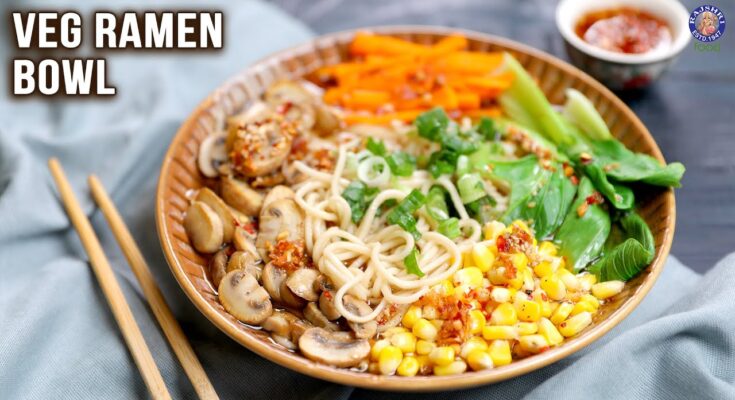Vegetarian Ramen Recipe: Vegetarian ramen is more than just a bowl of noodles—it’s a wholesome experience packed with vibrant colors, textures, and rich umami flavor. Whether you’re a full-time vegetarian or just looking to cut back on meat, vegetarian ramen offers a satisfying, hearty meal that feels indulgent without compromising on nutrition. The beauty of this dish lies in its versatility. You can make it spicy, savory, creamy, or light depending on your mood and available ingredients.
One of the best things about vegetarian ramen is its ability to highlight seasonal produce. A winter version may include roasted root vegetables and miso broth, while a summer bowl might lean on bok choy and a lighter soy-based broth. With plant-based diets growing in popularity, vegetarian ramen isn’t just a trend—it’s a smart and flavorful choice. Plus, it’s a great gateway recipe for those trying to explore plant-based cooking without giving up comfort food.
And let’s not forget: ramen is comfort food at its finest. The warmth of the broth, the chew of the noodles, the crunch of fresh toppings—it hits all the right notes. Vegetarian ramen allows you to enjoy all of that while still sticking to your values or dietary goals. No wonder it’s taking over restaurant menus and home kitchens alike.
What Makes It Different from Traditional Ramen?
Traditional ramen is often made with pork, chicken, or seafood-based broth, making it a no-go for vegetarians. But that doesn’t mean you have to sacrifice flavor. Vegetarian ramen relies on ingredients like kombu (edible kelp), dried shiitake mushrooms, miso paste, and soy sauce to recreate that same umami depth without animal products.
Instead of chashu pork or chicken, vegetarian versions use tofu, tempeh, seitan, or even marinated mushrooms to deliver texture and protein. The broth in vegetarian ramen is often cleaner and lighter but still deeply satisfying. Many home cooks even find the vegetarian version quicker and easier to prepare since it doesn’t involve simmering meat bones for hours.
Another key difference is in the creativity of toppings. While traditional ramen may be limited to meats and eggs, vegetarian ramen opens up a whole world of options—grilled corn, pickled vegetables, crispy garlic, and more. This flexibility makes vegetarian ramen not only accessible but also endlessly customizable to suit your tastes.
Ingredients You’ll Need
Broth Base Essentials
Creating a flavorful broth is the heart and soul of any ramen recipe. Without a good base, your ramen will fall flat. For vegetarian ramen, you want a broth that’s rich in umami, slightly salty, and aromatic. Here are the core ingredients you’ll need:
- Kombu (Dried Kelp): Adds natural umami and depth.
- Dried Shiitake Mushrooms: Infuse the broth with a meaty, earthy flavor.
- Garlic and Ginger: Aromatic essentials that build flavor.
- Onion or Scallions: Provide sweetness and body to the broth.
- Soy Sauce or Tamari: For saltiness and depth.
- Miso Paste: Adds creaminess and a fermented punch.
- Sesame Oil: Enhances aroma and gives a nutty finish.
- Vegetable Broth or Water: As the liquid base.
Optional but excellent add-ins:
- White Pepper or Chili Flakes (for heat)
- Mirin or Rice Vinegar (for acidity and balance)
- Star Anise or Clove (for complexity)
Let the broth simmer for at least 30 minutes to an hour to fully develop the flavors. The longer it simmers, the better the taste.
Vegetables That Work Best in Ramen
Vegetables aren’t just filler in vegetarian ramen—they’re the stars of the show. Choose a mix of textures, colors, and flavors to make your bowl pop both visually and taste-wise. Some of the best vegetables for ramen include:
- Bok Choy or Napa Cabbage: Mild, tender greens that soften in the broth.
- Carrots: Add sweetness and crunch; julienne them for best texture.
- Corn Kernels: Sweet and juicy, they contrast beautifully with savory broth.
- Bean Sprouts: Provide a fresh crunch.
- Spinach or Kale: Nutritious greens that wilt perfectly in hot broth.
- Shiitake or Enoki Mushrooms: Bring extra umami and chewiness.
- Zucchini or Squash: Light and tender, perfect for summer bowls.
Roasting or sautéing your veggies before adding them can bring out even more flavor. And don’t forget pickled elements—like pickled bamboo shoots or radishes—for an added tang that balances the richness of the broth.
Noodles and Protein Substitutes
Ramen noodles are typically made with wheat, but you can also find gluten-free or rice-based alternatives. Here are your main choices:
- Fresh Ramen Noodles: Chewy and authentic—usually found in Asian markets.
- Dried Ramen Noodles: More accessible and still tasty.
- Soba or Udon Noodles: A great substitute if ramen noodles are unavailable.
- Rice Noodles (for gluten-free eaters): Light, with a delicate texture.
As for proteins, vegetarian ramen offers plenty of options that are just as satisfying as meat:
- Tofu (Firm or Silken): Can be fried, baked, or added soft into the broth.
- Tempeh: Nutty and firm; great when marinated and grilled.
- Seitan: Chewy and protein-rich; mimics the texture of meat.
- Boiled Eggs (for ovo-vegetarians): Classic ramen topping.
- Mushrooms: A great meaty alternative—try portobello or shiitake for richness.
For extra flavor, marinate your tofu or tempeh in soy sauce, garlic, and ginger before pan-frying until crispy.
Toppings for That Perfect Finish
Toppings are where ramen truly shines—they’re the finishing touch that ties everything together. Here’s a list of must-have vegetarian ramen toppings:
- Soft-Boiled Eggs (if not fully vegan)
- Toasted Nori or Seaweed Sheets
- Green Onions (Scallions), finely chopped
- Crispy Garlic Chips or Fried Shallots
- Toasted Sesame Seeds
- Chili Oil or Sriracha
- Pickled Ginger or Radishes
- Corn and Butter Combo (for Hokkaido-style)
- Lime Wedges or Lemon Zest (for brightness)
Mix and match your toppings depending on the flavor profile you’re going for—rich, spicy, tangy, or fresh. You can also add crushed peanuts, microgreens, or shredded cabbage for extra crunch and nutrition.
Step-by-Step Guide to Making Vegetarian Ramen
Step 1: Prepare the Broth
In a large pot, heat sesame oil and sauté garlic, ginger, and green onions until fragrant. Add vegetable broth, soy sauce, miso paste, and a dash of rice vinegar. Simmer for 15–20 minutes to develop deep umami flavor.
Step 2: Prep Your Vegetables
Slice mushrooms, bok choy, carrots, and corn. Keep them ready for quick cooking later.
Step 3: Cook the Noodles Just Right
Boil ramen noodles according to package instructions until al dente. Drain and toss lightly with a few drops of oil to prevent sticking.
Step 4: Sauté or Cook the Protein
Pan-fry tofu, tempeh, or seitan until golden and crisp on the edges.
Step 5: Assemble the Ramen Bowl
Place noodles in a bowl, pour over hot broth, add veggies and protein, and garnish with sesame seeds, scallions, and chili oil—warm, nourishing, and full of flavor!
Tips for Customizing Your Ramen Bowl
Make It Spicy, Savory, or Sweet
Ramen isn’t a one-flavor-fits-all dish—it’s a canvas, and you’re the artist. Whether you’re a spice lover, a fan of umami-rich broths, or someone who enjoys a touch of sweetness, vegetarian ramen can be tweaked to suit your exact cravings.
If you like it spicy, go bold. Add chili oil, sriracha, or even a spoonful of gochujang (Korean chili paste) into the broth. You can also sauté your garlic and onions with red pepper flakes for that subtle background heat. For a smoky kick, toss in a dried chipotle pepper while the broth simmers—it’ll infuse a slow-burn spice that lingers just enough.
Prefer a savory, umami-forward ramen? Boost that depth by doubling down on miso paste, soy sauce, and even adding a splash of mushroom soy sauce or tamari. Don’t underestimate the magic of toasted sesame oil, either—it gives your bowl that rich, nutty aroma that lingers deliciously.
Now, if you’re someone who loves a bit of sweetness in your food (don’t worry, we’re not judging), add a dash of mirin or maple syrup to your broth. It balances out the saltiness and gives your ramen a rounder flavor. Roasted vegetables like sweet potatoes, corn, or caramelized onions can also add a natural sweetness that pairs beautifully with bold broth flavors.
The point here is: make your ramen yours. Don’t be afraid to experiment with small changes. A drizzle of coconut milk can transform your ramen into a Thai-inspired creamy bowl. A splash of lime juice can brighten everything up instantly. A spoon of peanut butter? Trust us—it turns the broth luxuriously creamy and adds a satay-like twist.
Texture Tips: Crunch vs. Softness
The key to unforgettable ramen isn’t just in the flavor—it’s in the texture. A good bowl has contrast: chewy noodles, soft vegetables, and toppings that crunch or pop in your mouth. Without that variety, even the most flavorful broth can feel flat.
Start with the noodles—they should be al dente, never mushy. Cooking them separately and rinsing them under cold water helps maintain that perfect bite. If you reheat them, just dip them quickly in hot water before assembling your bowl.
Next, your vegetables. Wilted greens like spinach or bok choy give a silky texture, while roasted carrots or pan-fried mushrooms add some meatiness. But here’s the fun part—contrast them with crisp elements. Think bean sprouts, shredded raw cabbage, or thinly sliced radish. These add that fresh, satisfying crunch.
Want even more texture? Try:
- Toasted nuts or seeds (like sesame or crushed peanuts)
- Fried garlic or shallots – ultra-crispy and loaded with flavor
- Seaweed snacks or nori sheets – crisp until they melt into the hot broth
- Pickled toppings – add both tang and a unique mouthfeel
Don’t forget the protein texture either. Tofu, when pan-fried or air-fried, gets that delightful golden crust. Tempeh brings a chewy bite. Even a soft-boiled egg, with its creamy yolk, adds a rich contrast to crunchy veggies.
A great rule of thumb? Try to have three contrasting textures in every bowl: soft (noodles or greens), chewy (tofu or mushrooms), and crunchy (sprouts, nuts, or pickled radish). Your mouth will thank you for it.
Playing with Global Fusion Styles
Here’s where you can get really creative—bring global flair into your vegetarian ramen. Ramen is Japanese in origin, but its adaptability makes it the perfect base for fusion. Adding international ingredients can lead to incredible flavor combinations you never expected.
Craving something with Thai or Vietnamese flair? Stir in some coconut milk, lemongrass, and Thai red curry paste into your broth. Top with fresh cilantro, lime wedges, and maybe some crushed peanuts. Boom—Thai curry ramen.
For a Korean-inspired twist, swap in gochujang and kimchi. Add tofu, napa cabbage, and a soft-boiled egg. The spicy, fermented punch of kimchi makes the broth extra vibrant and bold.
Want a Mediterranean vibe? Try a broth flavored with sun-dried tomatoes, garlic, and rosemary, then top with grilled zucchini, chickpeas, and a swirl of pesto. Sounds wild? It works.
You can even play with Mexican-style ramen—add chipotle peppers, black beans, corn, and avocado slices. A little lime zest over the top, and it’s like a tortilla soup got a Japanese makeover.
This kind of experimentation makes vegetarian ramen endlessly exciting. And the best part? You can make it fit your mood, your pantry, or even leftovers in your fridge. Just remember to keep a balance of flavors: salty, sweet, sour, spicy, and umami. You’ll know you’ve nailed it when you take that first bite and go, “Whoa.”
Nutritional Benefits of Vegetarian Ramen
Rich in Antioxidants and Fiber
One of the most underrated aspects of vegetarian ramen is just how nutrient-packed it can be. While ramen gets a bad rep as college dorm food, a homemade vegetarian version is lightyears ahead in terms of health benefits—especially when you fill it with fresh, whole foods.
First off, veggies like carrots, broccoli, spinach, and bok choy are loaded with antioxidants like beta-carotene, lutein, and flavonoids. These compounds fight off oxidative stress in the body and reduce inflammation. That means stronger immunity, better skin, and improved overall health.
Then there’s fiber—and lots of it. Vegetables, tofu, tempeh, and even the noodles (especially if you’re using whole-grain or soba noodles) all contribute to your daily fiber intake. Fiber is key for healthy digestion, keeping your gut happy, and even regulating blood sugar levels.
If you’re using miso paste, you’re also getting a dose of probiotics, which help balance gut flora and support your digestive system. Not to mention the mushrooms—especially shiitake—are packed with compounds that support immune function.
It’s not just about the individual ingredients either—it’s about the balance. A bowl of vegetarian ramen can give you:
- Carbohydrates from the noodles (energy!)
- Plant-based protein from tofu, tempeh, or legumes
- Healthy fats from sesame oil or avocado toppings
- Vitamins and minerals from a rainbow of vegetables
In short, this isn’t fast food. This is fuel food. And the best part? You get to eat something that’s as nourishing as it is comforting. It’s like a multivitamin in noodle form—but way tastier.
Common Mistakes to Avoid
Overcooking the Noodles
We’ve all been there—you’re multitasking in the kitchen, the broth smells amazing, the veggies are prepped, and then… your noodles turn to mush. Overcooked noodles are one of the most common (and frustrating) ramen mistakes.
Ramen noodles, especially the fresh kind, cook super quickly—usually in 3 to 5 minutes, tops. Even dried varieties don’t need much longer. If you let them sit in hot broth for too long after cooking, they’ll keep soaking up liquid and lose that signature springy chew.
Here’s how to get it right every time:
- Always cook noodles separately from the broth.
- Check them 1 minute before the package says they’re done.
- Once cooked, rinse under cold water to stop the cooking and remove extra starch.
- Reheat by dunking in hot water for just a few seconds before adding to your bowl.
Also, don’t cook noodles in bulk ahead of time and store them in the fridge with the broth—they’ll turn into a soggy clump. For meal prep, keep the broth and noodles separate until serving. Your future self will thank you.
Using Bland Broth
You could have the best noodles, the freshest veggies, and the fanciest toppings—but if your broth is bland, the whole bowl falls flat. Broth is the soul of ramen. It’s not just hot water with soy sauce. It needs complexity, layers, and umami.
A bland broth usually means you skipped essential flavor-building steps. Did you simmer kombu and shiitake mushrooms long enough? Did you sauté your aromatics—onion, garlic, ginger—before adding liquid? Did you taste as you went?
If your broth tastes dull, try these quick fixes:
- Add a spoonful of miso paste for depth and creaminess.
- Splash in more soy sauce, tamari, or mushroom broth.
- Drizzle some toasted sesame oil for nutty aroma.
- Brighten it with rice vinegar or a squeeze of lime.
- Stir in a bit of chili oil, garlic paste, or gochujang for bold flavor.
And remember—low and slow is the key to good broth. Let it simmer gently for at least 30–45 minutes, or longer if you have the time. Taste along the way, and don’t be afraid to adjust. Great broth makes everything else sing.
Not Layering Flavors Properly
A lot of people make the mistake of dumping everything into one pot, stirring, and calling it ramen. But the best bowls are built layer by layer, just like in professional kitchens.
Layering means:
- Start with aromatics (garlic, ginger, onions). Sauté them in oil first to activate their flavors.
- Add umami ingredients like miso, soy sauce, and mushrooms early on so they infuse the broth.
- Cook proteins and veggies separately so you can control texture and doneness.
- Season in stages—not just at the end. Taste as you build.
- Finish with toppings that bring freshness, crunch, spice, or richness.
This approach transforms your ramen from good to unforgettable. It’s the difference between a bowl that tastes like boiled soy sauce and one that feels like a warm hug from your favorite chef. Don’t skip the layering—your taste buds will notice.
Storing and Reheating Tips
Best Practices for Storage
So, you’ve made an epic batch of vegetarian ramen—but now you’ve got leftovers. Good news: with the right storage technique, you can enjoy it again without sacrificing texture or flavor.
First and foremost: store all components separately.
- Broth goes in one airtight container. Let it cool to room temp first, then refrigerate for up to 4–5 days or freeze for up to 2 months.
- Noodles should be drained well, tossed lightly in oil to prevent sticking, and stored in their own container.
- Toppings and vegetables should be kept dry and refrigerated separately. If they’re marinated or pickled, even better—they’ll develop more flavor over time.
- Tofu or protein can also be stored in a separate container and reheated just before serving.
This way, nothing gets soggy or breaks down in storage. You’ll thank yourself when it’s time for round two.
How to Reheat Without Losing Flavor
Reheating ramen isn’t as simple as microwaving everything in one bowl. Here’s the right way to bring it back to life:
- Reheat the broth on the stove over medium heat. Don’t boil it—just bring it to a simmer. Taste it again and adjust seasoning if needed (flavors might have mellowed in the fridge).
- Rewarm the noodles by quickly dipping them in hot water for 30 seconds. They’ll bounce back like new.
- Heat proteins in a pan with a little oil if they were sautéed or roasted. If they were served cold (like marinated tofu), just bring them to room temp.
- Assemble fresh, just like you did the first time. Noodles first, broth second, then toppings.
Doing it this way means you still get a bowl with balanced flavors and distinct textures—not one mushy mess.
Pairing Ideas: What Goes Well with Vegetarian Ramen
Best Drinks and Side Dishes
A good bowl of ramen is a meal in itself, but if you’re planning a dinner party or just want to round out your experience, adding the right side dishes and drinks can elevate everything.
Perfect sides for vegetarian ramen:
- Edamame: Lightly salted and steamed, these are the classic starter.
- Gyoza (veggie dumplings): Pan-fried until crispy and served with dipping sauce.
- Seaweed salad: Tangy, light, and refreshing—great contrast to the hot ramen.
- Kimchi: Spicy, fermented, and cuts through the richness of the broth.
- Pickled cucumbers or radish: Crunchy and acidic, great for balance.
As for drinks:
- Green tea or jasmine tea pairs beautifully with the savory broth.
- Sake or plum wine adds a traditional Japanese touch.
- For a non-alcoholic option, try cucumber mint water or coconut water—refreshing and hydrating.
Avoid heavy sides or overly sweet drinks. Ramen is rich enough. Think light, fresh, and simple to complement—not compete with—the main dish.
Dessert Ideas for a Complete Meal
After a comforting bowl of ramen, something light and sweet is the perfect end note. You want to refresh your palate without going overboard.
Here are a few dessert ideas that work beautifully:
- Mochi: Soft, chewy, and available in tons of flavors (matcha, mango, red bean).
- Fruit sorbet: Especially citrus or berry—it’s cleansing and cool.
- Matcha pudding or green tea ice cream: A classic Japanese finish with earthy sweetness.
- Yuzu tart: Light, tangy, and beautifully fragrant.
- Coconut milk chia pudding: Mild, creamy, and customizable with fruits or spices.
Keep it portioned small and flavor-forward. The goal is to refresh, not overwhelm. You’ll walk away from the meal feeling full, satisfied, and totally content.
FAQs about Vegetarian Ramen Recipe
1. Can I make this gluten-free?
Absolutely! Swap out wheat-based ramen noodles for rice noodles, glass noodles, or 100% buckwheat soba. Use tamari instead of soy sauce, and double-check that your miso paste is gluten-free.
2. What are the best noodles for vegetarian ramen?
Fresh ramen noodles are ideal for texture and authenticity. If you can’t find them, dried ramen, soba, or even udon work well. For a lighter version, try zucchini noodles or shirataki noodles.
3. Can I make the broth ahead of time?
Yes! In fact, it’s even better the next day. Store it in the fridge for up to 5 days or freeze it in portions for up to 2 months. Just reheat gently and adjust seasoning before serving.
4. What are the best plant-based protein options?
Top picks include tofu, tempeh, seitan, chickpeas, and mushrooms (especially shiitake or portobello). Each brings a different texture and flavor, so mix and match for variety.
5. Can I freeze vegetarian ramen?
You can freeze the broth and some cooked vegetables, but avoid freezing noodles—they turn mushy. Keep all components separate, freeze in portions, and assemble fresh when ready to eat.
Conclusion
From crafting a complex, layered broth to arranging colorful, textured toppings, vegetarian ramen is more than a meal—it’s a creative process. It gives you space to experiment, try new flavors, and build something beautiful one element at a time.
Whether you’re cooking for yourself, impressing guests, or just trying to eat more plant-based meals, this recipe delivers comfort, nourishment, and flavor in every bite.
So roll up your sleeves, grab your favorite noodles, and start building your perfect bowl. Trust me—it’ll become your new favorite ritual.



